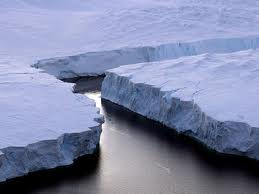 An iceberg twice the size of Manhattan tore off one of Greenland’s largest glaciers, illustrating another dramatic change to the warming island.
An iceberg twice the size of Manhattan tore off one of Greenland’s largest glaciers, illustrating another dramatic change to the warming island.
For several years, scientists had been watching a long crack near the tip of the northerly Petermann Glacier. On Monday, NASA satellites showed it had broken completely, freeing an iceberg measuring 46 square miles.
A massive ice sheet covers about four-fifths of Greenland. Petermann Glacier is mostly on land, but a segment sticks out over water like a frozen tongue, and that’s where the break occurred.
The same glacier spawned an iceberg twice that size two years ago. Together, the breaks made a large change that’s got the attention of researchers.
“It’s dramatic. It’s disturbing,” said University of Delaware professor Andreas Muenchow, who was one of the first researchers to notice the break. “We have data for 150 years and we see changes that we have not seen before.”
“It’s one of the manifestations that Greenland is changing very fast,” he said.
Researchers suspect global warming is to blame, but can’t prove it conclusively yet. Glaciers do calve icebergs naturally, but what’s happened in the last three years to Petermann is unprecedented, Muenchow and other scientists say.
“This is not part of natural variations anymore,” said NASA glaciologist Eric Rignot, who camped on Petermann 10 years ago.
Ohio State University ice scientist Ian Howat said there is still a chance it could be normal calving, like losing a fingernail that has grown too long, but any further loss would show it’s not natural: “We’re still in the phase of scratching our heads and figuring out how big a deal this really is.”
Many of Greenland’s southern glaciers have been melting at an unusually rapid pace. The Petermann break brings large ice loss much farther north than in the past, said Ted Scambos, lead scientist at the National Snow and Ice Data Center in Boulder, Colo.
If it continues, and more of the Petermann is lost, the melting would push up sea levels, he said. The ice lost so far was already floating, so the breaks don’t add to global sea levels.
Northern Greenland and Canada have been warming five times faster than the average global temperature, Muenchow said. Temperatures have increased there by about 4 degrees Fahrenheit in the last 30 years, Scambos said.
The new iceberg is likely to follow the path of the one in 2010, Muenchow said. That broke apart into smaller icebergs headed north, then west and last year started landing in Newfoundland, he said.
It’s more than glaciers in Greenland that are melting. Scientists also reported this week that the Arctic had the largest sea ice loss on record for June.
mohave daily news
Leave a Reply
You must be logged in to post a comment.